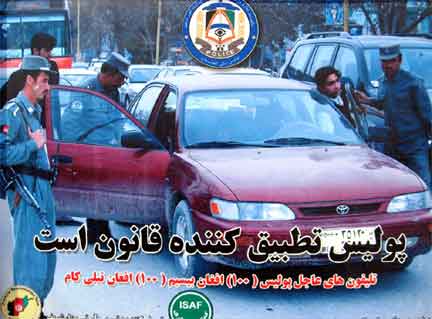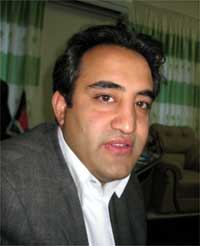Afghanistan after the elections - security
Conspiracy theories blossom as violence increases in northern Afghanistan
by Tony Cross
Article published on the 2009-11-17 Latest update 2009-11-24 09:37 TU

A security poster in Mazar-e-Sherif, which says 'police enforce the law' and provides emergency phone numbers
(Photo: Manu Pochez/RFI)
After his investiture on Thursday, President Hamid Karzai must again try and tackle the Taliban insurgency in his country. While parts of the south are ungovernable, the north has been relatively untouched. But this year has seen an upsurge in violence, giving rise to conspiracy theories and accusations of dirty tricks.
The north of Afghanistan resisted the Taliban when they were in power and has seen relatively little armed opposition to Hamid Karzai’s government.
But Taliban ally Gulbuddin Hekmatyar is active in the region, claiming responsibility for a deadly attack on French troops last year.
Recent months have seen an increase in Taliban activity in some areas, like Mazar-e-Sharif, the north’s biggest town.
Khutbuddin, an unemployed man who has come to Mazar-e-Sharif from Baghlan province, whiles away the hours outside the city’s famous blue mosque. He says Taliban fighters have come into the province from outside but have recruited locally.
People join them because they are unemployed, he says.
“Those who come from other provinces, they come with money and they pay them. It’s because of money.”
While the Taliban are largely Pashtuns, the north is populated by other ethnic groups: Tajiks, Uzbeks, Hazara and Turkmen.
The Hazara, who are mostly Shia-Muslims, while most Afghans are Sunni, suffered particularly under Taliban rule. Most of the 8,000 people massacred in Mazar-e-Sherif in 1998 after the Taliban recaptured the town were Shia.
So the rebels are still unpopular in the north.
But ethnic division also means continuing tension with Kabul. Provincial Council leader Farhad Azimi claims that Pashtuns still control key government posts.
Interview: Farhad Azimi, Chair of the provincial council, Mazar-e-Sharif
“They lost their power, but our central government is now dominated by Pashtuns: Minister of Defence, Minister for Interior Affairs,” he says. “[The] few other ministers from other ethnic groups they replaced with the Pashtuns.”
But Azimi points out that the government is not popular in the south, implying that Pashtuns there are steeped in Taliban values, citing the widespread electoral fraud in the region and a case of schoolgirls having acid thrown in their faces.
The rise in violence in some northern districts led some to believe that political rivals in Kabul have sabotaged northern politicians’ security efforts. That is certainly the view of Provincial Governor Atta Mohammad.
He accuses Interior Minister Mohammed Hanif Atmar of negligence, or worse.
Atmar has replaced some police chiefs close to Atta and tried to recruit local militias against the insurgents, following the model of Sunni militias in Iraq, who have been recruited to fight Al- Qaida.
Atta is not impressed.
“The negligence of the Interior Minister, his lack of capacity, lack of proper planning, distribution of weapons to bad elements in the name of developing militia forces, removal of some good, competent police officers and appointment of his loyal men to the police force and his dispute with some of the authorities in the north – it’s all contributing to the insecurity.”
Karzai himself stunned the country in October when he announced that there would be inquiring into reports that helicopters had been transporting Taliban fighters to the north, adding that he had known about the action for some time.
It is widely believed that such air transit could only have operated with the knowledge of local and foreign powers who control air traffic. So conspiracy theories blossomed.
People wondered if southern politicians were stirring up the rebellion to undermine their northern rivals, or if international forces were fanning the flames of violence to provide an excuse for staying the country and exploiting its mineral wealth.
The regional head of the Afghan Human Rights Commission, Qazi Same, believes that “invisible hands” may be trying to destabilise the area. But he dismisses as completely illogical the idea that either local or international armed forces are involved,
“They suffer casualties every day. That they try to spread insecurity, logically that’s not believable,” he says.
Since the election, there has been less violence in the region. But the Taliban threat continues, as do tensions between the provinces and the centre.






